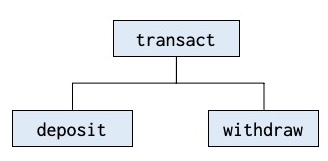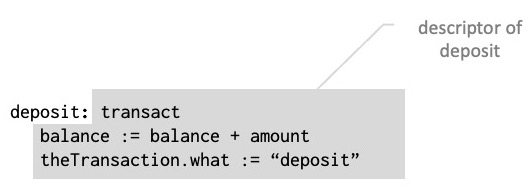In this section, we introduce submethods, which makes it possible to organise methods in a hierarchy similar to a class hierarchy using subclasses. As for subclass and superclass, submethod and supermehtod are dual terms. A submethod is a method that has another method as a supermetod, and thus a supermethod is a method being used to define submethods.
One primary use of methods as supermethods is to define new control abstractions, which may be used as control structures like if-then, etc. In chapter , we show examples of how to define such control abstractions, and chapter have further examples.
In section we introduced class Transaction and augmented deposit and withdraw to record each deposit and withdraw on a given Account:
deposit(amount: var float):
balance := balance + amount
transactions.insert(
Transaction("deposit", clock.today, clock.now, amount))
withdraw(amount: var float) -> newB: var float:
balance:= balance - amount
transactions.insert(
Transaction("withdraw", clock.today, clock.now, amount))They both invoke transactions.insert with almost identical arguments. Both deposit and withdraw perform transactions on the Account and we would therefore like to reflect this in the model of the bank account.
To do this, we introduce a common supermethod transact:
transact(amount: var float):
theTransaction: ref Transaction
theTransaction := Transaction("", clock.today, clock.now, amount))
inner(transact)
transactions.insert(theTransaction)The method transact takes care of recording the transactions in the transactions object. It generates a Transaction object and assigns it to the reference variable theTransaction. Then it executes an inner(transact), which has the effect that possible statements in submethods of transact are executed. We explain inner in section below.
We may now rewrite deposit and withdraw to become submethods of transact:
deposit: transact
balance := balance + amount
theTransaction.what := “deposit”
withdraw: transact
balance := balance – amount
theTransaction.what := “withdraw”By writing transact after deposit: and withdraw: both are defined as submethods of transact.
It is the same mechanism as for classes and subclasses; properties of transact becomes properties of both deposit and withdraw, including both data-items and statements.
It is therefore illustrated similarly, methods, however, with another color than classes.

The effect of this is that the code in transact works as a wrapper around the code in deposit and withdraw. Invocation of deposit and withdraw starts by execution of the statements in transact; here execution of inner(transact) implies that the statements in deposit and withdraw are executed; finally the statements after inner(transact) are executed.
In the next section, we give a more detailed description of inner.
Method descriptor with a supermethod
The following figure shows that the method descriptor for deposit includes its supermethod transact:

